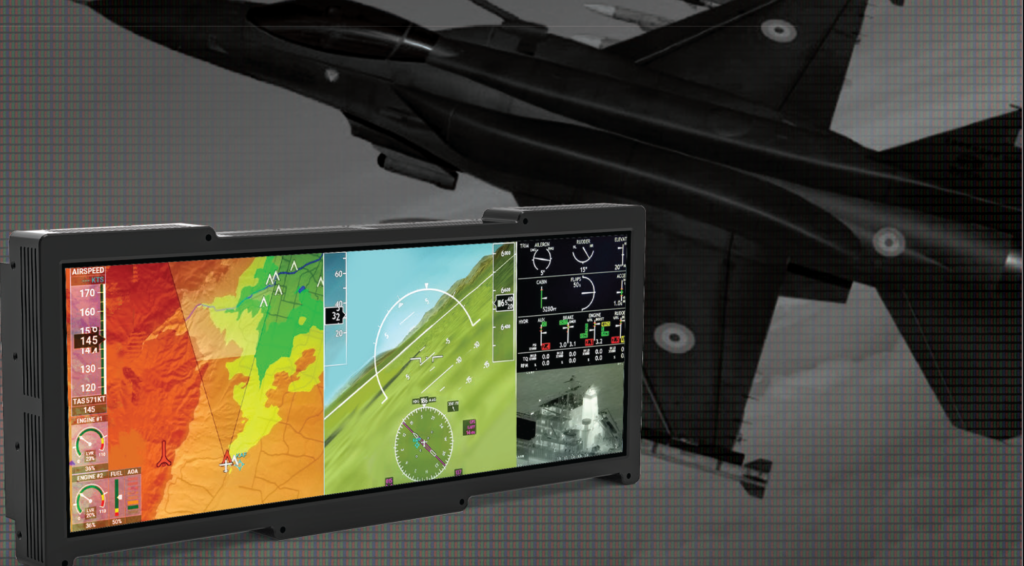What Is a Display Head Assembly?
A Display Head Assembly is a vital component within aviation and military systems, serving as the central hub for cockpit and command center equipment. Comprising an Optical Stack, Control Interface (HMI), Driving electronics, Connectivity Ports, Housing, and Mounting structure, the DHA ensures seamless functionality.
In the aviation sphere, Display Head Assemblies prove indispensable, seamlessly integrating critical flight information, navigation data, and engine parameters into an aircraft’s avionics suite. Similarly, in military applications, DHAs shine in command centers, vehicles, or aircraft, presenting tactical information and mission-critical data with unparalleled clarity and precision. Each Display Head Assembly is meticulously crafted, with configurations and specifications tailored to meet the unique requirements of its application.
The Architecture of a Display Head Assembly
The Display Screen serves as the core feature of the Display Head Assembly. Nestled in the optical stack, the Display Screen utilizes LCD, micro LED, or other display technology for a clear visual interface.
The Human-Machine Interface (HMI) enables human interaction with technology, allowing communication between the person and the device through buttons, touchscreens, or other methods. Depending on the application and level of integration, the driving electronics can encompass backlight functionalities, video functionalities, power and touchscreen control.
The Optical Stack is a sophisticated layering of components meticulously designed to enhance the quality and functionality of displayed images. Anchored by the display panel, this stack incorporates optical filters, polarizing layers, touchscreen elements, protective layers, and optical bonding. Its configuration is instrumental in elevating the visibility, contrast, and durability of on-screen information. Customized to tackle specific environmental challenges and user requirements, the optical stack guarantees optimal performance in diverse conditions, aligning seamlessly with the stringent standards of avionics and military operations. Particularly in military and aerospace applications, the optical stack may encompass additional layers such as optically clear heaters, EMI shields, touch screens, and other specialized optical layers, all finely tuned to meet the unique demands of each application.
Military and aerospace, energy, manufacturing, oil and gas, transportation, and many other essential industries rely on HMI technology to facilitate communication between human operators and technological systems. In the dynamic arenas of aviation and military operations, Human-Machine Interfaces (HMIs) serve as the nexus for pilots, operators, and commanders to interact with aircraft, vehicles, or command and control systems. This interaction encompasses tasks ranging from information retrieval to command input and performance monitoring. Key HMI components include input controls like buttons, rotary encoders, touchscreens, and feedback mechanisms such as indicators or alarms.
As a result of many advancements during its development, HMIs have evolved into an intuitive, immersive technology. In contemporary settings, advanced HMIs leverage cutting-edge technologies like touchscreens, gesture controls, voice recognition, and augmented reality to elevate user experience and system efficiency. A robust emphasis on a human-centered design, including ergonomics and usability, ensures the safe and effective operation of intricate systems in modern contexts.
Driving electronics play a pivotal role in the seamless functionality of Display Head Assemblies (DHAs), overseeing critical functions such as backlight system controls, video driving controls, heater management, power distribution, and touchscreen control. These electronic components act as the nerve center, ensuring the synchronized operation of diverse elements within the DHA. The backlight system controls contribute to optimal screen visibility, video driving controls manage the display of information, and heater management ensures functionality in varying environmental conditions. An intuitive touchscreen interface facilitates user interaction while power distribution is meticulously managed to propel the display and associated electronics. These driving electronics form the backbone of DHAs, ensuring reliability and efficiency in avionics, military, and aerospace applications.
The metalwork or bezel in Display Head Assemblies (DHAs) is a foundational component that goes beyond its structural role, influencing both aesthetics and functionality. As the outer frame surrounds the display, the bezel contributes to the DHA’s overall design, providing a sleek and cohesive appearance. Beyond aesthetics, it is a protective barrier, enhancing the assembly’s durability and robustness. The choice of materials and precision in metalwork is critical, ensuring resistance to environmental factors such as temperature variations and vibrations. Additionally, the bezel can incorporate features for easy installation and maintenance. In essence, the metalwork or bezel plays a dual role, contributing to the visual appeal and physical resilience of DHAs in various applications, including avionics and military contexts.
Conclusion
In conclusion, the intricate design of Display Head Assemblies (DHAs) revolves around a core structure, including the Display Screen, Human-Machine Interface (HMI), Optical Stack, Driving Electronics, and Metalwork or Bezel. The symbiotic integration of these components ensures optimal performance and durability in demanding environments, especially in aviation and military applications. The Display Screen, governed by sophisticated optical technology, delivers a clear visual interface, while the HMI serves as the vital link between users and complex systems, employing advanced technologies for enhanced interaction. Driving Electronics act as the nerve center, orchestrating critical functions, and the Metalwork or Bezel not only contributes to aesthetics but also provides a protective barrier, ensuring resilience in challenging conditions. This holistic approach to DHA design underscores Cevians’ commitment to reliability, efficiency, and user-centric functionality in the ever-evolving landscapes of avionics and military operations.

